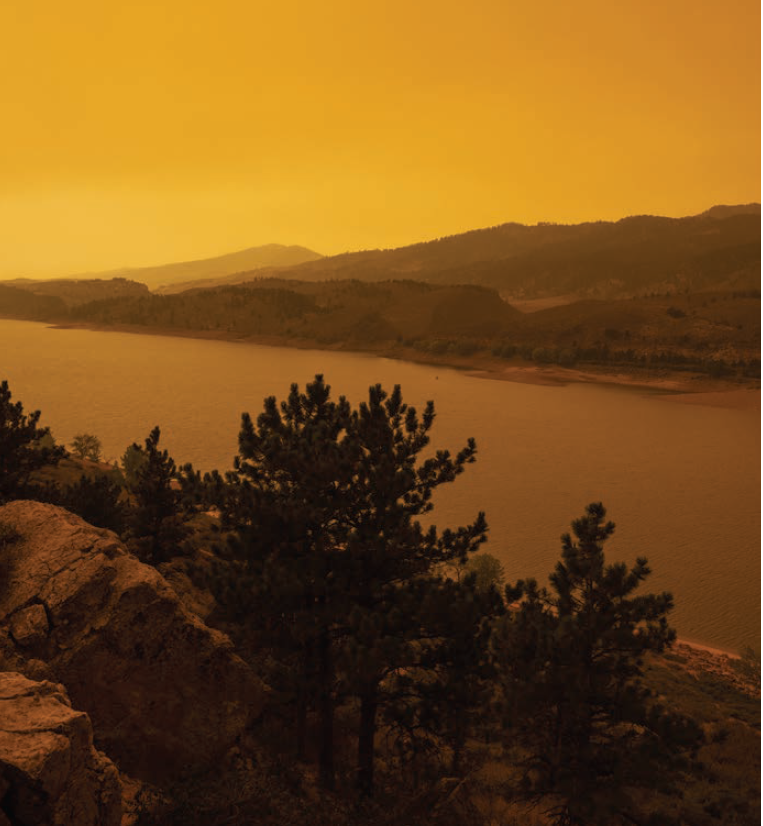The Air We Breathe
By Alan S. Rudolph

The Cameron Peak Fire smoke plume descends on Horsetooth Reservoir, west of Fort Collins, Colo., Sept. 7, 2020. Photo: William A. Cotton, CSU Photography
In the last two years in Colorado, we have experienced historic wildfires and a pandemic that has brought attention to the air we breathe like never before. Many of us share personal stories that relate to the air we breathe and our health. More frequently, we are challenged with poor air quality due to wildfires and, with the outbreak of the SARS-CoV-2 virus, we are now understanding how or when friends or family were exposed or got sick from transmission through the air.
Understanding the air around us has long been a subject of CSU research discoveries and impacts. Our University is home to leading national atmospheric science assets, most recently installing the GOES-r weather satellite in our Cooperative Institute for Research in the Atmosphere, a National Oceanic and Atmospheric Administration national center of excellence for extreme weather predictions, including release of the annual U.S. hurricane prediction. Our Department of Atmospheric Science is also nationally ranked and trains the next generation of leaders in fundamentals of our climate at a time when our planet’s climate will need new leaders to address the climate challenges of our future. We have added key thought leaders, including two new Walter Scott, Jr. Presidential Endowed Chairs, Dr. Jim Hurrell and Dr. Tami Bond, who bring further attention to models to better understand global climate change and indoor air dynamics and quality.
The pandemic brought the air we breathe from the global and national scale right to the front of our masked faces.
Across our campus, we have pursued understanding and counteractions of a harmful virus and how it travels from one person to another indoors or outdoors. Our public health laboratory at the Energy Institute has tested mask designs and studied the transmission of the virus in indoor settings and specific-use cases, such as in orchestral instruments and singers in collaboration with our School of Music, Theatre, and Dance. They have also characterized and tested indoor air quality and exposure related to indoor cooking with cookstoves used around the world.
Our continued research achievements in air quality and health are enabled by significant strategic investments on our campus that have contributed to our understanding of air quality and its influences on integrated health. In 2016, we started the Partnership for Air Quality Climate and Health, an investment from SoGES and the Office of the Vice President for Research, to establish interdisciplinary research teams that address the interplay between air quality and health. The breadth of activity in these investments covered emissions from gas and oil, wildfires, disease, and industrial pollutants. We doubled down on these investments in 2018 with a cluster hire of eight new faculty focused on new research topics in air quality and health, with particular attention to diversity, inclusion, social justice, and equitable access to quality air and health. An additional cluster hire of new faculty in the study of communities of microbes (called the microbiome) that reside in soil, water, animals, and people followed this investment. The communication and interplay of microbes in our health are critical to issues across living systems, including nutrition, disease resistance, aging, soil health and crop yield, and our natural resources’ health, including water, forests, and diversity of species on our lands.
These investments in new ideas and people contributed significantly to our work on climate and health in responding to issues of our day, including the COVID-19 pandemic and to the wildfire smoke in our region. They enabled the creation of new facilities to characterize exposure in controlled environments, including specific exposures to humans and in the study of the passage of microbes in micro-simulated contained environments, such as wet markets or other unique ecosystems. These strategic investments will be critical to understanding the effects of air quality on animals, people, and our environment.
Our ability to address future air quality and health issues was recognized recently in the announcement of a new award from the National Science Foundation to CSU researchers and partners that will allow a multiyear interdisciplinary investigation to characterize and understand microbes in the atmosphere. This award is anchored in our One Health Institute under the direction of National Academy of Sciences member Sue VandeWoude. The institute focuses on the interplay between the health of the environment, animals, and people and will position the work on aerobiome for maximum impacts. This award will enable the pursuit of a new chapter in our understanding of the complex interactions of microbes in the air and how they contribute to many aspects of health on our planet. This exciting new award will allow CSU to continue to galvanize discoveries in climate and health and provide future applications to improving our health in the air we breathe in Colorado and around the world.